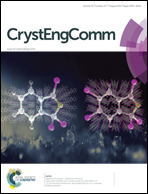Influence of ligand environments on the structures and luminescence properties of homoleptic cadmium(ii) pyridyl functionalized dithiocarbamates†
Abstract
Novel homoleptic pyridyl-3(N) functionalised dithiocarbamate complexes having polymeric, [Cd(L)2] (L = L1, C5H4NCH2NCS2CH2C6H5 (1), L2, (C5H4NCH2)2NCS2 (2), L3, C5H4NCH2NCS2CH2C4H3O (3) and L4, C5H4NCH2NCS2CH2C4H3S (4)); dinuclear, [Cd(L)2]2 (L = L5, (C8H6NCH2NCS2CH2NC5H4) (5)) and trinuclear, [Cd(L6)2]3 (L6 = CH3C6H4CH2NCS2CH2C4H3O) (6)) structures have been synthesised and characterized by elemental analysis, IR, UV-vis, and 1H and 13C NMR spectroscopy and their structures have been elucidated by X-ray crystallography. In 1–4, the cadmium(II) ions are six-co-ordinate with two bidentate dithiocarbamate ligands (L1–L4) in an equatorial plane and axially bonded by Py(N) of the dithiocarbamate ligands on adjacent molecules, thus adopting a distorted octahedral geometry (CdS4N2) in 2-D polymeric structures. Complexes 1 and 2 are isomorphous and have similar structures to those of 3 and 4, although they differ significantly in architecture and topology. In 3 and 4, the metal atoms occupy centrosymmetric sites. In marked contrast to these polymeric structures, complex 5 derived from ligand L5 containing a bulky indolyl substituent proved to be a dinuclear complex. In 5, the metal atom has a square pyramidal geometry. As in 1–4, the dithiocarbamate ligand in 5 is uniquely bonded to the metal centres in a μ2,κ3-N,S,S bridging-chelating fashion. Ligand L6 containing furfuryl and tolulyl substituents yielded a spectacular centrosymmetric trinuclear complex 6 with the central metal atom in an octahedral environment and the two outer metal atoms in square pyramidal environments in which the dithiocarbamate ligands are bonded in a μ2,κ2-S,S chelating-bridging and S,S chelating manner within the same molecule. To the best of our knowledge, 1–4 and 5 and 6 are the first examples of 2-D coordination polymeric, dinuclear and trinuclear cadmium dithiocarbamates. All the complexes show bright luminescence emission in the solid state; the coordination polymers 1 and 2 are strongly luminescent.


 Please wait while we load your content...
Please wait while we load your content...